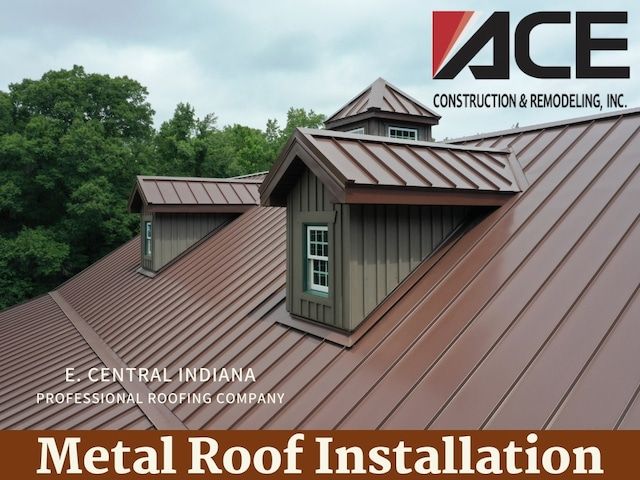The Pros and Cons of Metal Roof Installation
For homeowners looking to renovate, you may be considering installing a new roof. Perhaps you’ve done your homework and found that a metal roof installation could be a great way to modernize. There are many benefits that come with a metal roof, but it is one of the costlier options and should be carefully considered beforehand. Investing in one could be quite rewarding, but it’s worth taking time to decide whether it’s the right choice for you.
We suggest weighing the costs and benefits (particularly the preliminary financial commitment), and then decide whether installing a metal roof is a viable option for your home.
Benefits of Installing a Metal Roof
As one of the top-rated options for roofing materials, a metal roof brings a whole slew of benefits. To begin, they are incredibly durable. A steel roof, for instance, can last anywhere from four to seven decades, with proper maintenance. Metal is fire resistant, corrosion resistant, and can withstand powerful winds. So, if your region is subject to extreme elements, then a metal roof installation may be worth contemplating.
Next, they’re energy efficient. With a metal roof, you’ll be pleasantly surprised with a much lower heating bill in the winter, as you will a lower AC bill in the summer, especially if you’ve ever had an asphalt roof. Metal shingles, comparatively, absorb far less heat than asphalt does, relieving your HVAC system from the extra work of keeping your house cool in the summers and warm in the winters. These types of materials would not fare well in highly precipitous regions.
Another benefit of metal is that it resists moisture, a favorable trait for long-term damage prevention. This comes with a caveat, of course, which depends on what is layered underneath (we’ll explore this in more detail). Other roofing options like clay, concrete, or slate are highly porous, meaning they allow in moisture, thus more vulnerable to embrittlement and eventually, breakage.
Moisture resistance, consequently, makes a metal roof installation one of the safest options. A common but often invisible issue many homeowners face is mold, which accumulates from trapped moisture. Mold will not only deteriorate the stability of your home, but it is also unsafe to inhale, and people with certain preexisting conditions are at higher risk of health complications if exposed to mold long term.
If you do decide to install a metal roof, you’ll have to ensure certain precautions to prevent mold growth.
Drawbacks of a Metal Roof Installation
The first factor to consider is roof replacement cost. Because it is one of the better-rated roofing alternatives, it is also one of the more expensive ones. However, like other significant home repairs and renovations – a new deck or an in-ground pool, for instance – it will likely raise the value of your home.
The timing of such costly endeavors, though, could mean the difference between a significant investment return, or a paltry one. This will be subject to the housing market. If you plan to eventually sell your home, a real estate agent or home consultant can advise whether the state of the market makes it a good time to undergo a major renovation.
A metal roof is also quite dense, which means it can disrupt cell phone service. Due to the pandemic, the number of telework jobs have spiked; in many sectors, some reports say, remote work is here to stay. If this is the case for you, then spotty cell service may not be a tolerable repercussion of installing a metal roof.
If, however, this is already something you live with and are accustomed to, then perhaps it’s no added nuisance. But if your day-to-day household activities hinge heavily on reliable cell phone reception, you may want to consider other alternatives.
Next, determine what’s layered underneath the metal. The foundation under a metal roof will influence whether your roof could be subject to mold development later. If you decide to layer metal roofing atop another material, it must be a compatible substance. Plywood, for example, makes a great moisture-resistant material underneath a metal roof. To layer them properly, a layer of moisture-resistant foam sealant is required for mold prevention.
You might be wondering, then, what’s the best combination of materials to layer together? That will depend on your long-term objectives. If your stay in the home will be short-lived, then preventative steps may be less urgent, and not worth shelling out extra money. However, if you do want to maintain the long-term strength and condition of your roof, the prudent option would be to arrange for a plywood installation beneath your metal roof. Plywood stops moisture accrual, which over time will result in roof leaks and internal home damage.
Finally, metal roofs can be noisy – some may find the constant ting and ping during rain unpleasant. This will be another factor to plan for when sealing your roof to its foundation, as certain substances can muffle the sound.
Consult a Professional when Planning to Install a Metal Roof
With the right circumstances, a metal roof installation can be a fantastic investment. That said, due to costliness and potentially complex installation requirements, it’s wise to carefully weigh all factors first before deciding if it’s the right option for you. We recommend getting advice from a professional roofing company like Ace Construction & Remodeling. They can help you determine what are the best option available to you.





